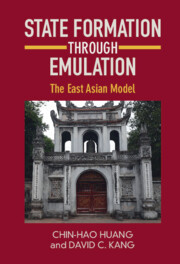Book contents
- State Formation through Emulation
- State Formation through Emulation
- Copyright page
- Epigraph
- Contents
- Preface
- 1 Introduction
- 2 Theories of State Formation and Diffusion
- 3 Phase I and Onwards
- 4 The Absence of Bellicist Pressures in State Formation, 400–800 CE
- 5 Phase II
- 6 Korea and Japan over the Centuries
- 7 Vietnam Emerges
- 8 Epistemic Communities and Regional Connections
- 9 Who Doesn’t Emulate?
- 10 Conclusion
- Appendix Major Events in Sinicization, 300–1100 CE
- Bibliography
- Index
3 - Phase I and Onwards
Hegemony, Bureaucracy, and Confucianism
Published online by Cambridge University Press: 21 July 2022
- State Formation through Emulation
- State Formation through Emulation
- Copyright page
- Epigraph
- Contents
- Preface
- 1 Introduction
- 2 Theories of State Formation and Diffusion
- 3 Phase I and Onwards
- 4 The Absence of Bellicist Pressures in State Formation, 400–800 CE
- 5 Phase II
- 6 Korea and Japan over the Centuries
- 7 Vietnam Emerges
- 8 Epistemic Communities and Regional Connections
- 9 Who Doesn’t Emulate?
- 10 Conclusion
- Appendix Major Events in Sinicization, 300–1100 CE
- Bibliography
- Index
Summary
As far back as the rise of unified Qin dynasty in 221 BCE, Asia’s predominant pattern has been concentrated power, not balance of power. Although Chinese power has waxed and waned over the centuries, what is perhaps most enduring was the centrality of China. Every other political actor that emerged in the past two thousand years emerged within the reality or idea of Chinese power. Regarding state formation, although the initial ideas for the subsequent bureaucratic Chinese state emerged at that time, it was neither pervasive, nor did the ideas result from war. Rather, the Qin state (221 to 206 BC) emerged as a result of hegemony, not about conquest or fighting or war. State formation was a result of unification and the need to administer a massive territory and also consolidate political rule beyond the aristocracy in the state and royal court itself. Indeed, what scant proto-bureaucratic innovations that did arise in Phase I were nascent and superficial in scope, and even in China the full Chinese state is usually seen to have emerged in the 7th and 8th centuries AD, not 800 years earlier during the Qin.
- Type
- Chapter
- Information
- State Formation through EmulationThe East Asian Model, pp. 31 - 57Publisher: Cambridge University PressPrint publication year: 2022

